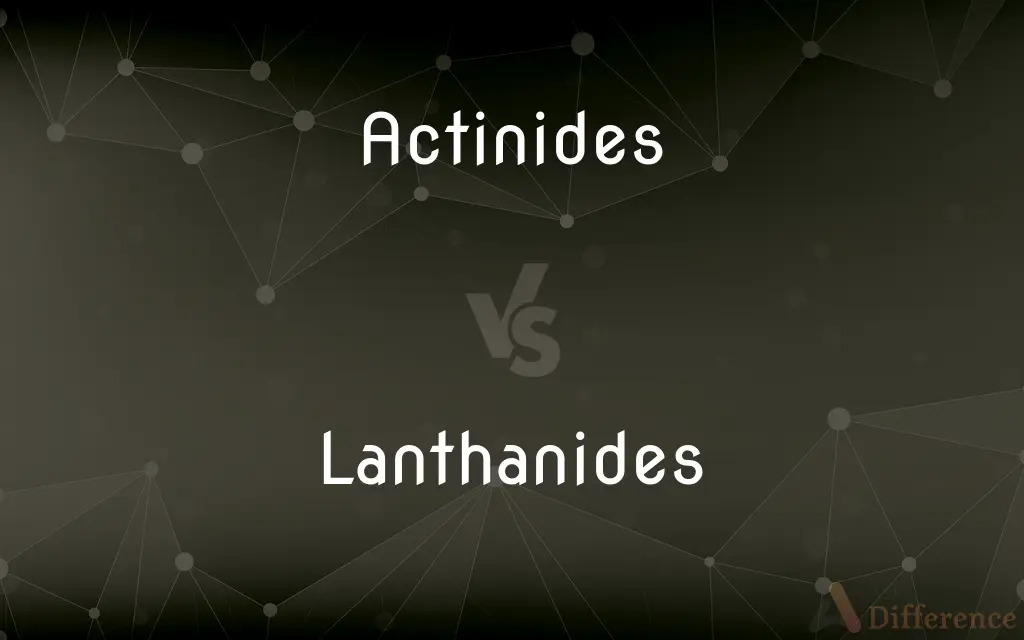Actinides vs. Lanthanides — What's the Difference?
Edited by Tayyaba Rehman — By Fiza Rafique — Published on December 24, 2023
Actinides are a series of elements from actinium to lawrencium (atomic numbers 89-103); Lanthanides are a series from lanthanum to lutetium (atomic numbers 57-71). Both series are f-block elements.

Difference Between Actinides and Lanthanides
Table of Contents
ADVERTISEMENT
Key Differences
Actinides and Lanthanides are two distinct series of elements located at the bottom of the periodic table. While they share similarities, they occupy separate rows, with Lanthanides above Actinides.
The Actinides series starts with actinium and ends with lawrencium, covering atomic numbers 89 to 103. On the other hand, Lanthanides begin with lanthanum and culminate in lutetium, spanning atomic numbers 57 to 71.
One of the most distinguishing features of Actinides is that they include elements with no stable isotopes; all of them are radioactive. In contrast, many Lanthanides possess stable isotopes and are naturally occurring.
Both Actinides and Lanthanides are f-block elements, meaning they are filling their 4f or 5f orbitals. While Lanthanides primarily fill their 4f orbitals, Actinides fill their 5f orbitals.
In terms of properties, Actinides are typically more reactive than Lanthanides. The chemistry of Lanthanides is somewhat more uniform than that of Actinides, which can exhibit a variety of oxidation states.
ADVERTISEMENT
Comparison Chart
Atomic Numbers
89-103
57-71
Location on Periodic Table
Second bottom row
First bottom row
Radioactivity
All are radioactive
Mostly non-radioactive
Orbital Filling
Filling 5f orbitals
Filling 4f orbitals
Oxidation States
Multiple oxidation states
Mostly +3 oxidation state
Compare with Definitions
Actinides
Elements with atomic numbers from 89 to 103.
The Actinides series includes both naturally occurring and man-made elements.
Lanthanides
A series of elements in the periodic table from lanthanum to lutetium.
The Lanthanides are known for their magnetic properties.
Actinides
A series of radioactive elements in the periodic table from actinium to lawrencium.
Uranium and thorium, part of the Actinides, are used as fuel in nuclear reactors.
Lanthanides
Elements with atomic numbers from 57 to 71.
Among the Lanthanides, neodymium is used in making strong permanent magnets.
Actinides
Elements that follow actinium in the periodic table.
Plutonium, an element in the Actinides series, has applications in nuclear weapons and reactors.
Lanthanides
The elements that primarily fill their 4f orbitals.
Lanthanides, filling their 4f orbitals, are often used in electronics.
Actinides
The elements that primarily fill their 5f orbitals.
Actinides, with their 5f orbital filling, display multiple oxidation states.
Lanthanides
A group of metals known for their similar chemical properties.
The chemistry of Lanthanides is more consistent than that of Actinides.
Actinides
A group of metals known for their radioactivity.
Most Actinides are hazardous due to their high radioactivity.
Lanthanides
Elements that follow lanthanum in the periodic table.
Cerium, a Lanthanide, is commonly used in catalytic converters.
Actinides
Any of a series of chemically similar, radioactive elements with atomic numbers ranging from 89 (actinium) through 103 (lawrencium). Also called actinoid.
Lanthanides
Plural of lanthanide
Actinides
Plural of actinide
Common Curiosities
Are all Actinides radioactive?
Yes, all Actinides are radioactive.
Do Lanthanides and Actinides belong to the same period?
No, Lanthanides and Actinides belong to separate periods on the periodic table.
Why are Actinides important in nuclear technology?
Actinides like uranium and plutonium are essential for nuclear reactors and weapons.
Are the chemical properties of Lanthanides consistent?
Yes, the chemical properties of Lanthanides are more uniform than Actinides.
Where are Lanthanides located on the periodic table?
Lanthanides are located in the first row at the bottom of the periodic table, spanning atomic numbers 57-71.
Are Actinides naturally occurring?
While some Actinides like uranium and thorium are naturally occurring, others are man-made.
What is a common oxidation state for Lanthanides?
Lanthanides commonly exhibit a +3 oxidation state.
Which elements mark the start and end of the Actinides series?
The Actinides series starts with actinium and ends with lawrencium.
What are Actinides in the context of the periodic table?
Actinides are a series of elements from actinium to lawrencium (atomic numbers 89-103).
What is a notable property of Lanthanides?
Lanthanides are known for their magnetic properties.
How do Actinides differ from other elements in terms of radioactivity?
All Actinides are radioactive, a characteristic not shared by all elements.
Why are Actinides and Lanthanides separated from the main body of the periodic table?
Actinides and Lanthanides are separated to keep the periodic table more compact and to highlight their unique properties.
Which series fills the 5f orbitals?
The Actinides series fills the 5f orbitals.
Which elements are the boundaries for the Lanthanides series?
The Lanthanides series starts with lanthanum and ends with lutetium.
What is the significance of neodymium among the Lanthanides?
Neodymium, a Lanthanide, is used to make powerful permanent magnets.
Share Your Discovery

Previous Comparison
Essential Amino Acids vs. Nonessential Amino Acids
Next Comparison
Gauss Law vs. Coulomb LawAuthor Spotlight
Written by
Fiza RafiqueFiza Rafique is a skilled content writer at AskDifference.com, where she meticulously refines and enhances written pieces. Drawing from her vast editorial expertise, Fiza ensures clarity, accuracy, and precision in every article. Passionate about language, she continually seeks to elevate the quality of content for readers worldwide.
Edited by
Tayyaba RehmanTayyaba Rehman is a distinguished writer, currently serving as a primary contributor to askdifference.com. As a researcher in semantics and etymology, Tayyaba's passion for the complexity of languages and their distinctions has found a perfect home on the platform. Tayyaba delves into the intricacies of language, distinguishing between commonly confused words and phrases, thereby providing clarity for readers worldwide.












































